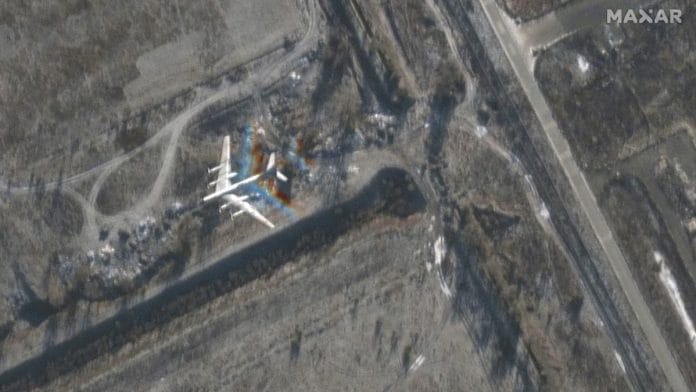New Delhi: With the war in Ukraine approaching the 10-month mark, a fresh escalation was reported late Monday with Moscow intercepting Ukrainian drones allegedly used to bomb airfields deep inside Russia.
Russia responded to the attack on its airfields in Ryazan and Saratov — far from the frontlines — with another wave of missile strikes across Ukraine, killing at least four and causing power outages as an alarmed Kyiv rushed to stabilise its electricity grid severely affected by prior airstrikes.
On Tuesday, Russia reported a third drone attack, this time on an airfield in Kursk. Citing video footage and the statement of the region’s governor, Roman Starovoyt, The Guardian reported that a drone struck an oil tank at the airfield but the fire was “localised”.
Starovoyt did not directly blame Ukraine for the attack but had hit out at the country’s armed forces for shelling the border areas of Kursk Oblast on the Russian side.
Also Read: How ‘graveyard’ of Russian tanks in Ukraine is upending armour doctrines worldwide & for India
Ukraine’s ‘audacious’ attacks
With Moscow accusing Kyiv of shelling the Zaporizhzhia nuclear power plant occupied by Russian troops, drone attacks on Ryazan and Saratov military airfields Monday, as well as the attack on Kursk Tuesday, have stood out as particularly “audacious” to international media and observers.
The reasoning behind this label lies not only in the locations of the three airfields — Ryazan is some 200 km southeast of Moscow, Saratov is around 300 km west of Russia’s border with Kazakhstan and Kursk is over 100 km northeast of Russia’s pre-war borders with Ukraine — but also in the weaponry allegedly used by Ukraine to target Russian aircraft.
As explained by Pjotr Sauer and Luke Harding for The Guardian, Russian aircraft primarily targeted at both airfields are the Tupolev Tu-95. These aircraft — along with Tupolev Tu-22, also stationed at Ryazan’s Dyagilevo base, and the Tupolev Tu-160 stationed at Saratov’s Engels-2 base — have been reportedly used by Russia to conduct airstrikes on Ukraine.
“Since October the Kremlin had used these strategic bombers to wreck Ukraine’s energy infrastructure, bit by bit, leaving millions without heat and electricity as winter arrives,” Harding writes about the aircraft.
“The explosion at the Engels-2 airfield led to anger among some prominent Russian pro-war bloggers who blamed the country’s military for the inability to protect its airbases,” Sauer reported on reactions in Russia.
‘Tactical ingenuity’?
Labelling the attacks as a sign of Ukraine’s “tactical ingenuity”, Harding further comments on speculation that Ukraine has developed a drone with a 1,000 km range to carry out such strikes and cites Ukrainian officials’ claims on previous usage.
However, verifiable details remain scant, with the most recent source from the Ukrainian side appearing to be the tech news website Mezha.media.
In October, the website reported that Ukraine’s state-run defence industry conglomerate Ukroboronprom had announced tests for a UAV, “either a drone or a cruise missile” with a range of 1,000 km. The UAV was being developed in response to the Iranian-made Shahed-136 kamikaze drones Russia deployed in attacks on Ukrainian cities in September.
“Range is 1000 km, weight of the combat unit is 75 kg. Putting the final touches on this one…Ukroboronprom has been operating in enhanced mode since the full-scale invasion. We almost tell you nothing (believe us), but this “nothing” works successfully in the battlefield, and some “nothing” gets successful trials from time to time,” Ukroboronprom stated on its Facebook page in October.
The conglomerate has yet to directly confirm whether its weaponry was used in Monday’s airfield attack. However, earlier Tuesday, it expressed continued support for the Ukrainian armed forces’ efforts and posted a photo album of what appeared to be warheads marked with text.
“A number of stages of successful trials are behind us. In order to fulfil the instructions of [Ukraine’s armed forces], we are moving to the stage of tests under the effect of electronic warfare…After we successfully test the drone under the influence of EW (electronic warfare), we hope to be able to test it in combat use. We promised to do it by the end of this year, we are trying to fulfil this promise,” Mezha.media quoted Ukroboronprom spokesperson Nataliia Sad as saying.
Meanwhile, the Russian Defence Ministry has made its own claim on the drone weaponry allegedly employed by Ukraine to carry out the attacks on its airfields, Soviet-made UAVs which, according to arms experts cited by the New York Times, may be the Tupolev TU-141 Strizh — a drone developed by the Soviet Union in the early 1970s and retired in 1989, that Ukraine now seems to have “repurposed”.
“Analysts say it can fly at 600 miles per hour at low altitudes, much like some cruise missiles, making it difficult to detect and shoot down,” added the NYT report.
(Edited by Amrtansh Arora)
Also Read: Who will pay the bill for rebuilding Ukraine? The answer lies in unfreezing Russian assets






